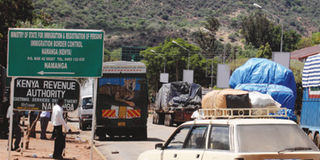36 trade barriers in EAC dropped in a year: official

PHOTO | FILE The Namanga border town between Kenya and Tanzania. EAC member states seek to encourage free movement of goods and people within the trading bloc.
What you need to know:
- With a population of 140 million, the EAC is still expanding and aims to accommodate South Sudan, Somalia and the Democratic Republic of Congo into a wider market
- Kenya has passed the Citizen and Immigration Act. Kenya and Rwanda has also won accolades for removing the requirement for work permits for East Africans
- President Kibaki and Uganda’s Yoweri Museveni agreed that much still needs to be done, especially developing priority infrastructure in rail transport, electricity generation, and maritime transport which are critical to regional integration, wealth creation and youth employment
The East African Community has eliminated 36 barriers to trade in the past year in a move aimed at boosting the region’s bid to attract investment from other economic blocs and countries to its expanded market.
With a population of 140 million, the EAC is still expanding and aims to accommodate South Sudan, Somalia and the Democratic Republic of Congo into a wider market.
The community also enjoys good relations with the Common Market for Southern Africa (Comesa) with a population of 385 million, and the Southern Africa Development Community (SADC) with 230 million people.
The chairman of EAC Council of Ministers Shem Bagaine said 36 non-tariff barriers (NTBs) have been eliminatedm and five remained. But he noted that another 11 NTBs have emerged.
Speaking at the 14th Heads of State ordinary summit in Nairobi on Friday, Mr Bagaine, Ugandan minister for the East African Community, praised Rwanda for enacting new immigration legislation that covers free movement of people.
Work permits
And Kenya has passed the Citizen and Immigration Act. Kenya and Rwanda has also won accolades for removing the requirement for work permits for East Africans.
President Kibaki, the bloc’s outgoing chairman, said the EAC had marked significant milestones since its revival in 1999.
The introduction of the Customs Union and the Common Market has increased intra-EAC trade threefold to about $4 billion annually.
“In addition, a number of non-tariff barriers have been eliminated, and we have embarked on joint infrastructure development projects. A case in point is the Arusha-Namanga-Athi River road which has been completed and which we launched this (last) week,” President Kibaki said.
To ease the movement of people across borders, he said, the East African Passport has been put into effect, student visas for East Africans abolished and the issuance of temporary travel documents within the region eased.
The Head of State said key community institutions such as the Secretariat, Legislative Assembly and Court of Justice were fully operational and contributing significantly to the integration process.
President Kibaki and Uganda’s Yoweri Museveni agreed that much still needs to be done, especially developing priority infrastructure in rail transport, electricity generation, and maritime transport which are critical to regional integration, wealth creation and youth employment.
This year’s summit centred on infrastructure development.
President Kibaki called on political, business, religious and other sectoral leaders in East Africa to “work together and mobilise our citizens so that we can create synergies of integration and achieve a vibrant vision of a stronger and more prosperous East African Community.”
President Museveni said the market for goods produced in the region was sufficient, but what is needed is infrastructure to link to goods to markets and electricity to power production.
He said delays at ports and borders were another a major barrier to trade in the region.
While it costs about $4,000 to transport a 40-foot container from Hong Kong to Mombasa by ship, the Ugandan leader noted that it costs $10,000 to move the same from Mombasa to Bujumbura.
President Museveni said the use of trucks instead of rail consumes 50 per cent of the cost; delays were responsible for the rest.
The Ugandan leader said regional land, minerals, water and human resources should be treasured as they are crucial to growth.
African Union Commission deputy chairperson Erastus Mwencha said African was emerging as a global power house and the EAC would be the entry point.
US sentiments
Similar sentiments were echoed by acting US Secretary of Commerce Rebecca Blank who noted that the economies of EAC member states grew by about six per cent last year while other parts of world did poorly.
Dr Mwencha said plans to establish Africa Free Trade Area were on course.
Dr Blank said the US would work closely with EAC to improve trade in the region. She also urged EAC leaders to ensure necessary reforms were carried out.
The United States also signed a letter of intent on commerce and trade with the EAC, its first in Africa.
The US has signed similar dialogue agreements with Brazil and India.
The pact is the only one the US has pursued on a regional, not a bilateral basis, and Dr Blank said this was due to US confidence in the EAC and its leaders.
The pact, she said, will promote trade and investment in key sectors, adding that a thriving private sector was important for economy to flourish.
The US move comes at a time when China has been trying to make inroads in the region as it eyes the continent’s huge resources.
EAC secretary-general Richard Sezibera also said as one of fastest-growing economic regions in the world, the EAC has great potential and needs only to address the issues of NTBs and other challenges facing it.




